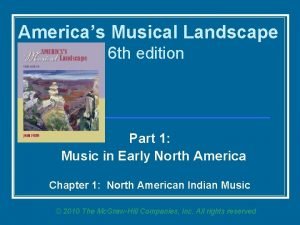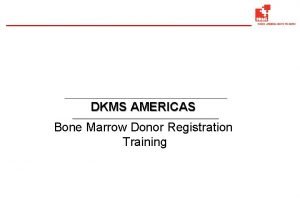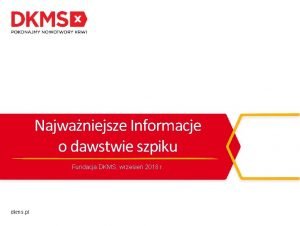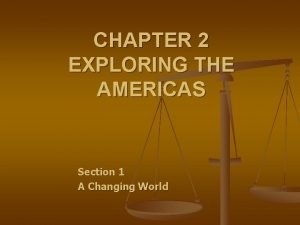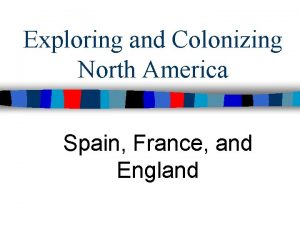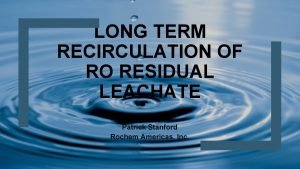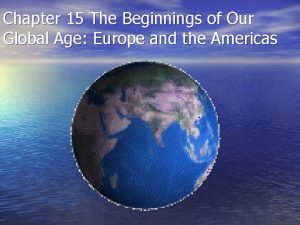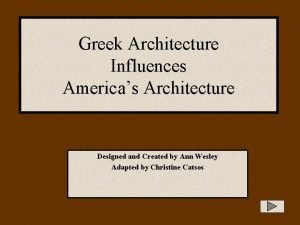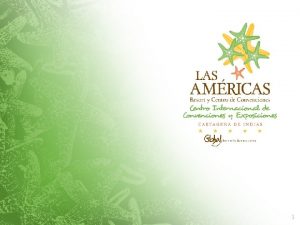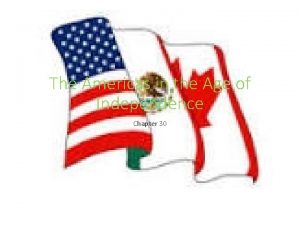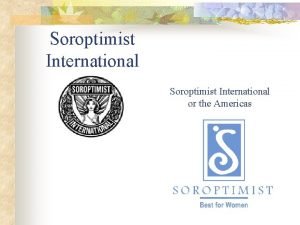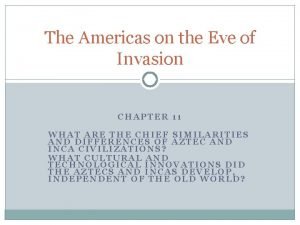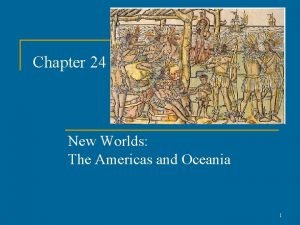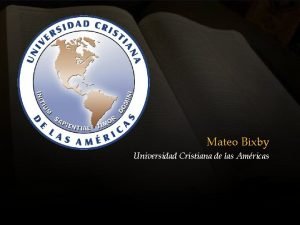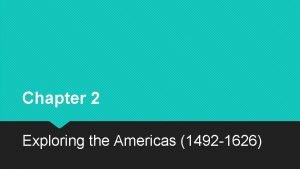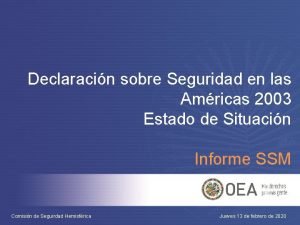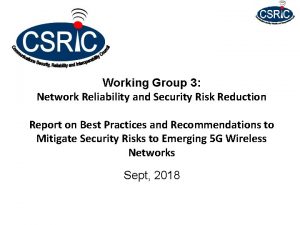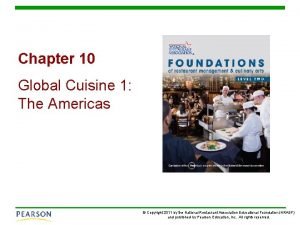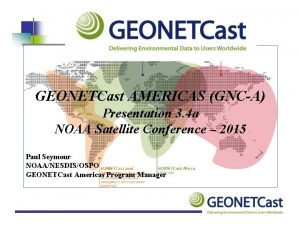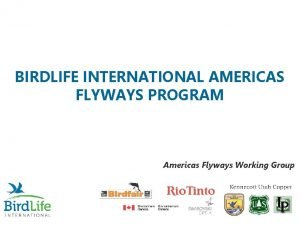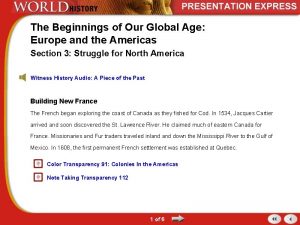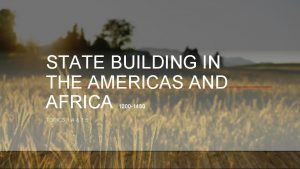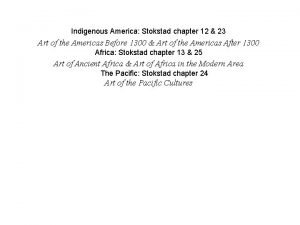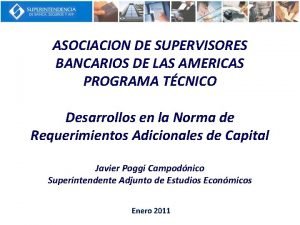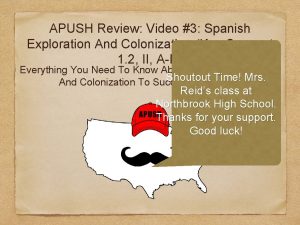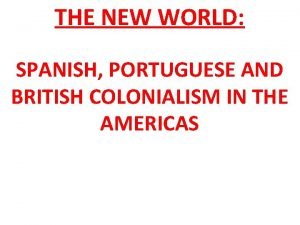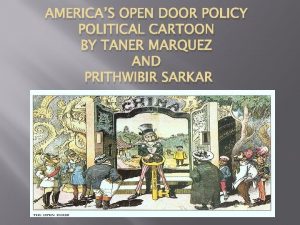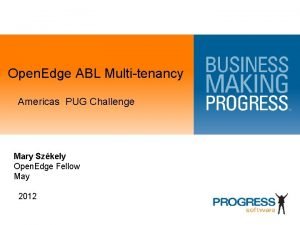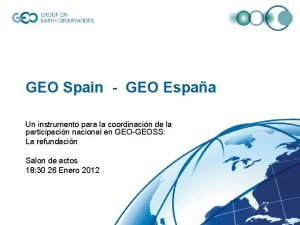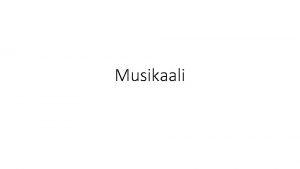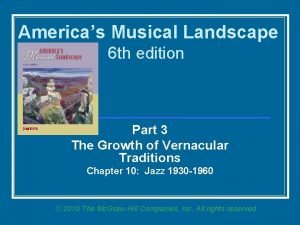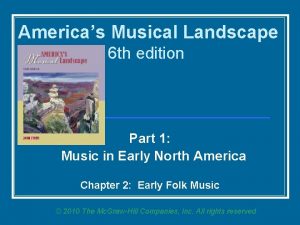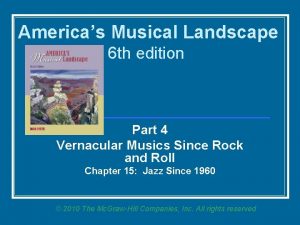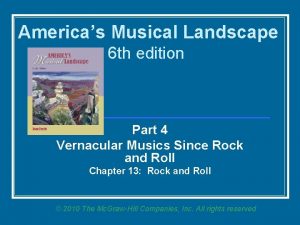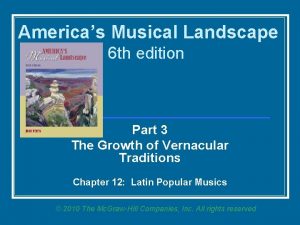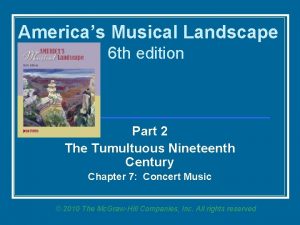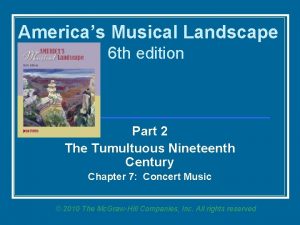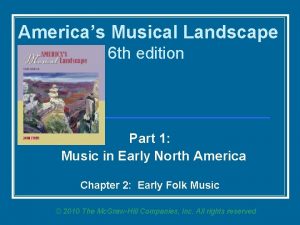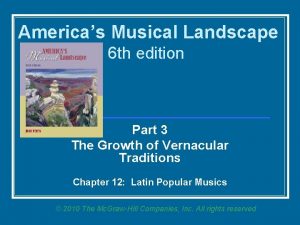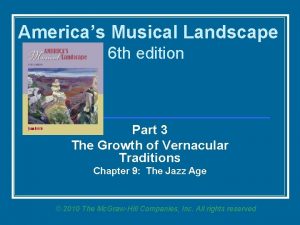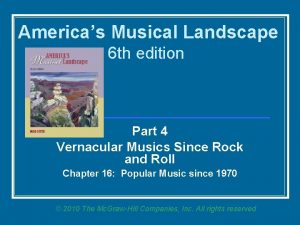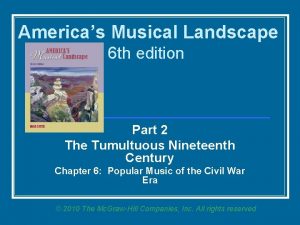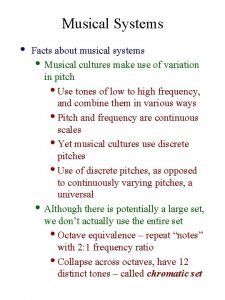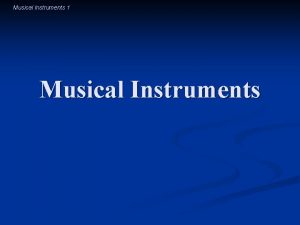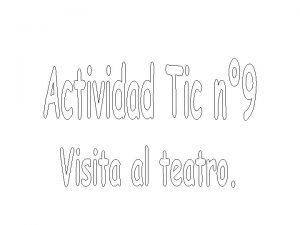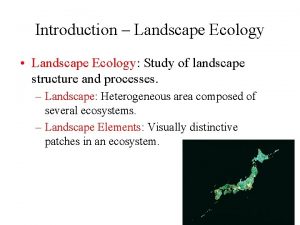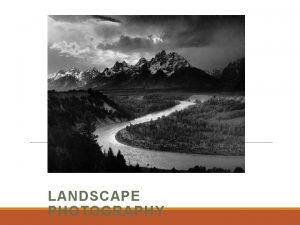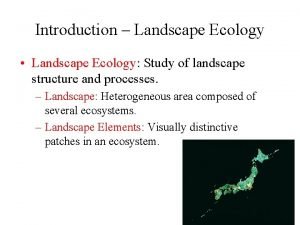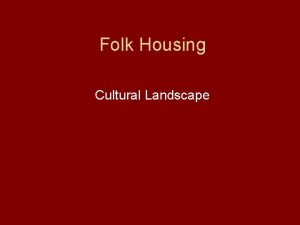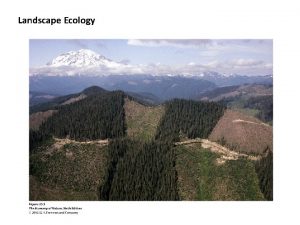Americas Musical Landscape 6 th edition Part 1




































- Slides: 36

America’s Musical Landscape 6 th edition Part 1: Music in Early North America Chapter 3: Religious Music in the Colonial, Revolutionary, and Federal Periods © 2010 The Mc. Graw-Hill Companies, Inc. All rights reserved

Religious Music in the Colonial, Revolutionary, and Federal Periods n As early as the sixteenth century, inhabitants of the New World experienced a variety of native and imported musics n Including Roman Catholic Music n n French and Spanish visitors accompanied their own worship with music The missionaries taught the music to the Indians in Florida and in the Southwest as part of the conversion process to Roman Catholicism © 2010 by The Mc. Graw-Hill Companies, Inc. All rights reserved. Part 1: Music in Early North America Chapter 3: Religious Music in the Colonial, Revolutionary, and Federal Periods 2

Music at the Spanish Missions n Taught by missionaries, American Indians learned n n n To sing and perform Christian songs and prayers, including choral singing To play instruments in church orchestras To create simple European-style instruments To sing traditional Spanish music, praise songs or hymns, and Gregorian Chant To perform at Christmas in musical nativity plays called Las Posadas (The Lodgings), about the struggles of Mary in finding a place to deliver the baby Jesus © 2010 by The Mc. Graw-Hill Companies, Inc. All rights reserved. Part 1: Music in Early North America Chapter 3: Religious Music in the Colonial, Revolutionary, and Federal Periods 3

Spanish missions n Remained active in California n Catholic church music was regularly performed there n n By missionaries By Native Americans n But the Mexican government ordered missions closed in 1833 n Musical instruments and music manuscripts of mass settings and church music have been found at mission sites n Catholic music remained important in regions inhabited by Spanish, French, or Mexican people © 2010 by The Mc. Graw-Hill Companies, Inc. All rights reserved. Part 1: Music in Early North America Chapter 3: Religious Music in the Colonial, Revolutionary, and Federal Periods 4

The Protestant Influence n The Protestant custom of singing psalms and hymns dominated the religious music experience in this country n Religious songs inspired and comforted people in the North and South n New England’s practices exerted the strongest and longest-lasting influence on American music © 2010 by The Mc. Graw-Hill Companies, Inc. All rights reserved. Part 1: Music in Early North America Chapter 3: Religious Music in the Colonial, Revolutionary, and Federal Periods 5

Psalm Tunes: Martin Luther and the Protestent Reformation n 1517 in Europe: German Catholic cleric Martin Luther (1483 -1546) instigated the Protestant Reformation, protesting practices of the Roman Catholic church n n Other people in northern European countries then formed their own Protestant sects Protestants sang hymns in their vernacular (common) language n Hymns: Had simple folklike tunes, easy to sing © 2010 by The Mc. Graw-Hill Companies, Inc. All rights reserved. Part 1: Music in Early North America Chapter 3: Religious Music in the Colonial, Revolutionary, and Federal Periods 6

Psalm Tunes: The Pilgrams and Puritans n Pilgrims and Puritans in New England in the early seventeenth century were Protestants n The protestations against Roman Catholicism included religious music © 2010 by The Mc. Graw-Hill Companies, Inc. All rights reserved. Pilgrams Going to Church Painted by George H. Boughton Part 1: Music in Early North America Chapter 3: Religious Music in the Colonial, Revolutionary, and Federal Periods 7

Psalm Tunes: The Pilgrims and Puritans n Followers of Swiss reformer John Calvin (1509 -1564) believed the only texts suitable for singing in a worship service were the psalms, 150 inspirational verses from the Old Testament of the Bible n Hymns, forbidden in a worship service, had freely written texts not necessarily based on Biblical passages or from church liturgy © 2010 by The Mc. Graw-Hill Companies, Inc. All rights reserved. Part 1: Music in Early North America Chapter 3: Religious Music in the Colonial, Revolutionary, and Federal Periods 8

Psalm tunes and the Calvinists n Calvinists retranslated the psalms into verses n n having a regular number of lines with patterns of weak and accented beats suitable for setting to music Calvinists believed the only purpose for music in a church service was to enhance expression of a religious text, not to stir emotions and not for the music itself n n In worship, sang a cappella (unaccompanied), in unison Outside of worship Calvinists enjoyed harmony and instrumental accompaniment with their psalm tunes © 2010 by The Mc. Graw-Hill Companies, Inc. All rights reserved. Part 1: Music in Early North America Chapter 3: Religious Music in the Colonial, Revolutionary, and Federal Periods 9

Psalm tunes became a folk tradition n Psalm tunes were n n n Folklike in nature Learned from oral experience Strophic in form n n 4 -line stanzas Ornamentation and variation in the singing was typical of folk song singing © 2010 by The Mc. Graw-Hill Companies, Inc. All rights reserved. Part 1: Music in Early North America Chapter 3: Religious Music in the Colonial, Revolutionary, and Federal Periods 10

Psalm tunes and psalters n Psalter: A book containing the metered and rhymed psalm verses, for use in congregational singing n n n Some psalters contained notated melodies Others had no music but only the words, which could be sung to familiar tunes 1539: The first collection of psalm tunes was printed in Switzerland © 2010 by The Mc. Graw-Hill Companies, Inc. All rights reserved. Part 1: Music in Early North America Chapter 3: Religious Music in the Colonial, Revolutionary, and Federal Periods 11

Psalm tunes and Psalters n Protestants sang hymns in their vernacular, or common, language n Most settlers didn’t bring musical instruments from England, but carried psalters n In 1640, the Bay Psalm Book was the first book printed in the New World n n Originally titled The Whole Book of Psalms Faithfully Translated into English Metre No tunes were included in the first edition; subsequent editions included music © 2010 by The Mc. Graw-Hill Companies, Inc. All rights reserved. Part 1: Music in Early North America Chapter 3: Religious Music in the Colonial, Revolutionary, and Federal Periods 12

Listening Example 11 Old Hundred (excerpt) By Louis Bourgeois (c. 1510 -c. 1560) Performers: Gregg Smith Singers Listening guide page 46 Also known as the Doxology, “Praise God, from Whom All Blessings Flow, ” this setting of Psalm 100 is the most famous psalm tune of all A four-part choir sings a cappella in this example with soprano melody Form: Strophic (only 1 stanza is heard) Meter: Quadruple, as well as long meter, entailing four line stanzas with eight syllables; any psalm in long meter could be sung to any long meter tune Rhythm: Altered from the original rhythm sung long ago © 2010 by The Mc. Graw-Hill Companies, Inc. All rights reserved. Part 1: Music in Early North America Chapter 3: Religious Music in the Colonial, Revolutionary, and Federal Periods 13

Other Protestant Music n John Calvin proscribed all music but the singing of unaccompanied psalm tunes in church n Martin Luther encouraged joyful singing of simple tunes and lighthearted texts in worship, some of which he composed n n Lutherans sang hymns, many of which are still sung today The famous “A Mighty Fortress is Our God” was by Martin Luther © 2010 by The Mc. Graw-Hill Companies, Inc. All rights reserved. Part 1: Music in Early North America Chapter 3: Religious Music in the Colonial, Revolutionary, and Federal Periods 14

Listening Example 12 ‘Tis the Gift to be Simple Composed by Joseph Brackett, Jr. Performed by string ensemble and choir Listening Guide page 48 This well-known tune has both sacred and secular associations. Sung at two Presidential inaugurations, it has been the inspiration for numerous composers of film scores and concert music. Form: Through composed Meter: Duple Melody: In a major key, moves mostly stepwise with few leaps Composed originally as a dance tune, the last two lines instruct the dancers as part of their worship expression © 2010 by The Mc. Graw-Hill Companies, Inc. All rights reserved. Part 1: Music in Early North America Chapter 3: Religious Music in the Colonial, Revolutionary, and Federal Periods 15

Other Protestant Music: German. Speaking Protestant Sects n Included n n n Mennonites Moravians Responding to William Penn’s policy of religious toleration, German-speaking Protestants fled persecution in Europe and settled in Pennsylvania, then in other regions as well n n In America, they kept much of their culture intact Their language and religious practices isolated them from the Protestant Anglo-American mainstream in the colonies © 2010 by The Mc. Graw-Hill Companies, Inc. All rights reserved. Part 1: Music in Early North America Chapter 3: Religious Music in the Colonial, Revolutionary, and Federal Periods 16

Other Protestant Music: Mennonites n 1683: Mennonites arrived in the US, mostly from Germany n Background n n n 1520 s: Mennonites were founded in Europe Refused on religious grounds to perform military service Rejected a state church, resulting in European persecution © 2010 by The Mc. Graw-Hill Companies, Inc. All rights reserved. Part 1: Music in Early North America Chapter 3: Religious Music in the Colonial, Revolutionary, and Federal Periods 17

Mennonite Music n n n Mennonites had their own hymnals and psalters, some with notated music for hymns and psalms But the old hymn tunes were preserved by oral tradition Mennonite schoolmasters compiled tune books with traditional texts and tunes: Example of Fraktur Title pages were decorated with Fraktur, a Pennsylvania-German Mennonite folk art with highly ornamental combination of calligraphy and script, including flowers, figures, and geometric designs © 2010 by The Mc. Graw-Hill Companies, Inc. All rights reserved. Part 1: Music in Early North America Chapter 3: Religious Music in the Colonial, Revolutionary, and Federal Periods 18

Other Protestant Music: Moravians and others n The late seventeenth century and early eighteenth century n Waves of emigrant Protestants came to America including n n Members of the English Society of Friends, called the Quakers The Shakers, a later offshoot from the Quakers § Shakers were so called because of the trembling induced by religious emotion during worship Methodists Moravians had a significant effect upon music in America © 2010 by The Mc. Graw-Hill Companies, Inc. All rights reserved. Part 1: Music in Early North America Chapter 3: Religious Music in the Colonial, Revolutionary, and Federal Periods 19

Moravians: Background n n Moravians arrived in 1735 together with Methodist missionaries and hymn writers John and Charles Wesley Moravians n n n Were persecuted in their homelands of Moravia and Bohemia Desired to serve as Christian missionaries to African and Native Americans Settled first in Georgia, then moved north to Bethlehem, Pennsylvania, as well as Salem (Winston-Salem), North Carolina and other areas in the East © 2010 by The Mc. Graw-Hill Companies, Inc. All rights reserved. Part 1: Music in Early North America Chapter 3: Religious Music in the Colonial, Revolutionary, and Federal Periods 20

Moravian Music had been important to the Moravians in Europe n Moravians n n n Composed and performed beautiful music in America Integrated hymns and other religious music into daily life Wrote both sacred and secular music n n n Songs and instrumental music The music was sophisticated and complex beyond the music of other early Americans Moravian music revealed their strong German and Czech heritage © 2010 by The Mc. Graw-Hill Companies, Inc. All rights reserved. Part 1: Music in Early North America Chapter 3: Religious Music in the Colonial, Revolutionary, and Federal Periods 21

Other Protestant Music: The Great Awakening n The Great Awakening, beginning in 1735, was a series of religious revival movements along the eastern seaboard n Started in New England cities n Many Puritans perceived a lessening of moral rectitude and an increase in intellectual interests § People on farms had a hard life on difficult land; abandoned religious customs of parish life n The Great Awakening spread from North to South, stirring religious fervor n Religious enthusiasm stimulated the rise of psalm singing and hymn singing © 2010 by The Mc. Graw-Hill Companies, Inc. All rights reserved. Part 1: Music in Early North America Chapter 3: Religious Music in the Colonial, Revolutionary, and Federal Periods 22

Early Efforts at Musical Reform n Most colonials had no opportunity to hear or practice good music n Few people could read the notated tunes in editions of the Bay Psalm Book printed after 1698 n n Old tunes were remembered differently in New England towns and villages § There was disagreement as to how to sing the tunes Lining Out came to be used for congregational singing: A leader sang one line of a psalm, the congregation repeated, each line performed successively in this manner © 2010 by The Mc. Graw-Hill Companies, Inc. All rights reserved. Part 1: Music in Early North America Chapter 3: Religious Music in the Colonial, Revolutionary, and Federal Periods 23

The Singing School Movement: Background n Lining out caused problems n Leaders often lacked musical training n Many had unattractive voices n Often sang songs in uncomfortable voice ranges n Embellished and distorted tunes n Better educated ministers printed collections of tunes with instructions in reading music notation n Amateur teachers often attempted simpler methods to teach music notation n These amateurs replaced the teaching ministers and became known as singing school masters © 2010 by The Mc. Graw-Hill Companies, Inc. All rights reserved. Part 1: Music in Early North America Chapter 3: Religious Music in the Colonial, Revolutionary, and Federal Periods 24

The Singing School Movement and the Singing School Masters n Singing school masters were former shopkeepers, merchants, farmers or tradesmen n n Became itinerant teachers Traveled from town to town Held singing schools in the local meetinghouse, church or school until the congregation learned to read music Singing schools were popular social events in addition to their educational purposes n n n People attended singing school several times per week A final performance demonstrated students’ accomplishments The singing school master then traveled to teach elsewhere © 2010 by The Mc. Graw-Hill Companies, Inc. All rights reserved. Part 1: Music in Early North America Chapter 3: Religious Music in the Colonial, Revolutionary, and Federal Periods 25

The Spread of the Singing School Movement n 1720: The Singing School Movement began in Boston n 1760 -1800: The movement spread into Canada, New York, New Jersey, Pennsylvania, Maryland, and the Carolinas n Into the 1800 s: Singing school masters offered instruction and inspiration especially in rural and remote areas n Pedagogy: n Singing school masters devised their own teaching materials n Compiled collections of familiar psalm tunes and other religious songs, often with written instruction about syllables to sing and elements of music n Composed their own tunes © 2010 by The Mc. Graw-Hill Companies, Inc. All rights reserved. Part 1: Music in Early North America Chapter 3: Religious Music in the Colonial, Revolutionary, and Federal Periods 26

The First New England School of Composers n A “school” of artists generally includes people n n Living at the same time Living in the same geographic region Sharing certain artistic goals and similarities of style The singing school masters were the First New England School of Composers, who were n The first Americans to write music with an American sound n n Their simple folklike songs had religious texts The tunes were suitable for congregational and home singing Shared the goals of teaching people to read music and sing Music they composed did not conform to anyone’s rules © 2010 by The Mc. Graw-Hill Companies, Inc. All rights reserved. Part 1: Music in Early North America Chapter 3: Religious Music in the Colonial, Revolutionary, and Federal Periods 27

The First New England School of Composers: William Billings n Billings (1746 -1800) became famous as a singing school master and composer n The first American to produce a book of tunes all of his own, the New England Psalm Singer (1770) n Ineffective copyright laws back then; he made meager profits n Billings considered “nature” as the best music teacher n Judged musical quality according to personal taste n Ignored conventional rules of music composition n He and others of the First New England School made unorthodox musical decisions to please their own ears n In his era he was eccentric but extremely talented © 2010 by The Mc. Graw-Hill Companies, Inc. All rights reserved. Part 1: Music in Early North America Chapter 3: Religious Music in the Colonial, Revolutionary, and Federal Periods 28

Listening Example 13 Chester Let tyrants shake their iron rod, And Slav’ry clank her galling chains. We Fear them not, we trust in God. New England’s God forever reigns. The foe comes on with haughty stride, Our troops advance with martial noise, Their vet’runs flee before our youth, And Generals yield to beardless boys. By William Billings Listening guide page 53 Form: Strophic Meter: Quadruple; march tempo Melody: Lies within a one octave range Texture: Homophonic; melody in tenor voice Timbre: A cappella four-part singing What grateful off’ring shall we bring, What shall we render to the Lord? Loud Hallelujahs let us Sing And praise his name on ev’ry Chord. “Chester” (1770): The principal marching song of New England troops during the Revolutionary War; the first American popular song © 2010 by The Mc. Graw-Hill Companies, Inc. All rights reserved. Part 1: Music in Early North America Chapter 3: Religious Music in the Colonial, Revolutionary, and Federal Periods 29

The First New England School of Composers: Performance Practices n The listening example “Chester” is a cappella on our CD n n But instruments might have doubled the voice parts Belief that church music must enhance—never detract from— worship caused prejudice againstrumental accompaniment of church music n n Instruments were sensuous and could not express text Prejudice lessened at the time of the First New England School n Organ, string, or wind accompaniments began to be used n Violin, the “devil’s fiddle” associated with dancing, slowly gained acceptance; bass viol, flute, clarinet, bassoon were used © 2010 by The Mc. Graw-Hill Companies, Inc. All rights reserved. Part 1: Music in Early North America Chapter 3: Religious Music in the Colonial, Revolutionary, and Federal Periods 30

The First New England School of Composers: Canons n Canon: A melody that forms meaningful harmonies when performed with “staggered entrances” n n Successive voices begin the same melody at later times Each voice continues to the end of the tune, dropping out at the end while remaining voices continue until they drop out in turn n “Voice”—A line of music, whether sung or played by musical instruments Each line is actually the same melody; a canon is polyphonic Circular Canon: A round, which continues to make harmonic sense when repeated any number of times © 2010 by The Mc. Graw-Hill Companies, Inc. All rights reserved. Part 1: Music in Early North America Chapter 3: Religious Music in the Colonial, Revolutionary, and Federal Periods 31

Listening Example 14 When Jesus Wept By William Billings Listening guide page 55 When Jesus wept, the falling tear In mercy flow’d beyond all bound; When Jesus groan’d, a trembling fear Seiz’d all the guilty world around. This is one of Billings’ best-known and best-loved songs Form: four-part circular canon or round Texture: Monophonic when the melody is performed in unison; polyphonic when performed in canon Meter: Triple Timbre: May be performed by four women’s voices, four men’s voices, or by a mixed chorus of soprano, alto, tenor, and bass © 2010 by The Mc. Graw-Hill Companies, Inc. All rights reserved. Part 1: Music in Early North America Chapter 3: Religious Music in the Colonial, Revolutionary, and Federal Periods 32

The First New England School of Composers: Fuging Tunes n Fuging tune: A new popular kind of song, late eighteenth century ABB n Form: Two sections, A and B: n A is homophonic : Melody in one voice (usually tenor); other voices (soprano, alto and bass) supply chordal harmony n B is polyphonic, begins with staggered entrances, gives each voice melodic interest § B is repeated § Four similar but independent lines of music, which end together on a chord n By 1800 about 1, 000 fuging tunes had been written n Fuging tunes offered interest, variety, challenge, and fun! © 2010 by The Mc. Graw-Hill Companies, Inc. All rights reserved. Part 1: Music in Early North America Chapter 3: Religious Music in the Colonial, Revolutionary, and Federal Periods 33

Listening Example 15 Sherburne By Daniel Read While shepherds watched their flocks by night All seated on the ground The angel of the Lord came down, And glory shone around. The words are from a famous hymn Written in 1700 by Nahum Tate Listening guide page 56 Daniel Read was the most popular composer of fuging tunes Texture: The first section (A) is homophonic, consisting of the first two lines of text; the second section (B) is repeated and has staggered entrances, each melodic line imitative of, but not identical to, the others © 2010 by The Mc. Graw-Hill Companies, Inc. All rights reserved. Part 1: Music in Early North America Chapter 3: Religious Music in the Colonial, Revolutionary, and Federal Periods 34

Impact of Singing School Masters upon American Culture n Besides Billings and Read, many singing school masters composed for their pupils n n n Psalm tunes Hymns Canons Fuging tunes They considered their music as teaching material n n Today we value it as strong, beautiful, and genuinely American Recent American composers have used the tunes of the First New England School of Composers and their contemporaries as inspiration and source material for current music © 2010 by The Mc. Graw-Hill Companies, Inc. All rights reserved. Part 1: Music in Early North America Chapter 3: Religious Music in the Colonial, Revolutionary, and Federal Periods 35

Chapter 3 Image Credit: Slide 7: Pilgrams Going to Church, painted by George H. Boughton. © COREL n Slide 18: An example of Fraktur. © Philadelphia Museum of Art/ Corbis n © 2010 by The Mc. Graw-Hill Companies, Inc. All rights reserved. Part 1: Music in Early North America Chapter 3: Religious Music in the Colonial, Revolutionary, and Federal Periods 36
 Yeibichai chant song
Yeibichai chant song Mis chapter 6
Mis chapter 6 Chapter 1
Chapter 1 Blood donation form
Blood donation form Dkms americas
Dkms americas Chapter 2 exploring the americas study guide
Chapter 2 exploring the americas study guide Colonial class system
Colonial class system Rochem americas
Rochem americas The beginnings of our global age europe and the americas
The beginnings of our global age europe and the americas Theatron of the americas
Theatron of the americas Centro de convenciones las americas
Centro de convenciones las americas The americas in the age of independence
The americas in the age of independence Soroptimist international of the americas
Soroptimist international of the americas The americas on the eve of invasion
The americas on the eve of invasion New worlds the americas and oceania
New worlds the americas and oceania Universidad cristiana de las americas
Universidad cristiana de las americas Chapter 2 exploring the americas answers
Chapter 2 exploring the americas answers Declaración sobre seguridad en las américas 2003
Declaración sobre seguridad en las américas 2003 Network reliability and security
Network reliability and security Chapter 10 global cuisine 1 the americas
Chapter 10 global cuisine 1 the americas Geonetcast americas
Geonetcast americas Hte americas
Hte americas The beginning of our global age europe and the americas
The beginning of our global age europe and the americas Greater miami aviation association
Greater miami aviation association Carpa nan
Carpa nan Art of the americas before 1300
Art of the americas before 1300 New worlds the americas and oceania
New worlds the americas and oceania Wholesale itf
Wholesale itf Chapter 16 people and empires in the americas
Chapter 16 people and empires in the americas Asociación de supervisores bancarios de las américas
Asociación de supervisores bancarios de las américas Spanish caste system in the americas
Spanish caste system in the americas Spanish caste system in the americas
Spanish caste system in the americas Open door policy political cartoons
Open door policy political cartoons Openedge multi-tenant database
Openedge multi-tenant database Chris penwell
Chris penwell Geo
Geo Transversal de las americas
Transversal de las americas
